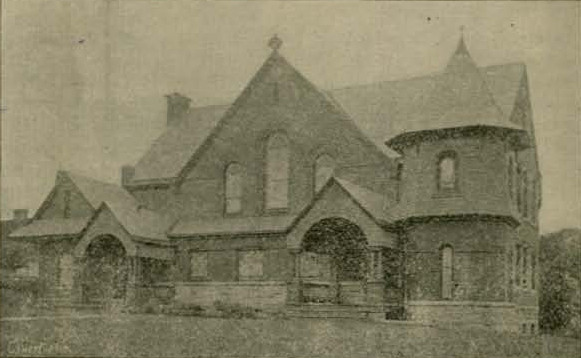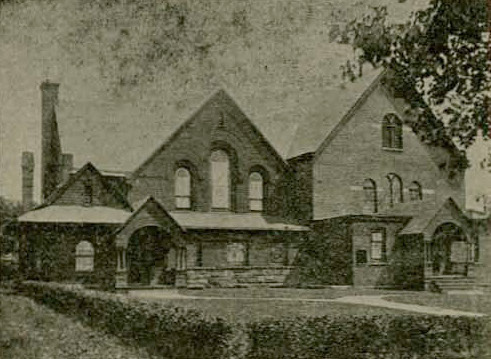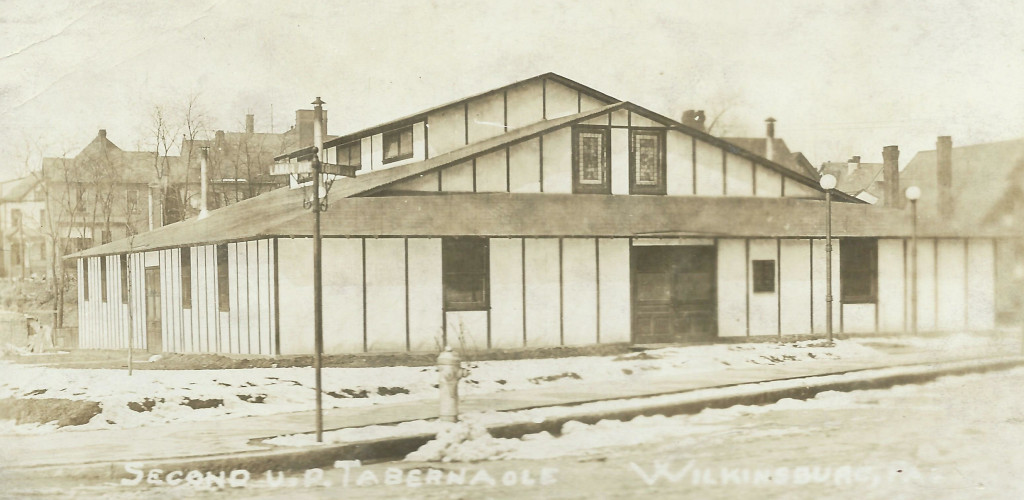The United Presbyterian Journal of December 1914 published papers that were read at the farewell service for the church building on December 6.
The closing day in the old church was one which will long be remembered. Although the day was quite stormy, the building was crowded at the morning communion service. Four hundred and fifty persons partook of the communion, and a number of others were present. A spirit of solemn gladness pervaded the place, and we all felt that it was good to be there. Eleven new members, whose names appear elsewhere in this paper, were received into the fellowship of the congregation. The sacrament of baptism was also administered to two children—Anna Louise, daughter of Mr. and Mrs. W. T. Hinton, and Frank Orlando, son of Mr. and Mrs. Earl R. Wagner.
At the evening service, which was attended by a large assemblage in spite of a very stormy night, the papers found in this issue were read and special music was provided by Mrs. David Whysall, Miss Cunningham and Mr. Geo. A. Jones. Many former members were present, and the occasion was one of mingled joy and sadness. On the following morning the work of razing the building was begun, so that room might be provided for the new stone structure which is to be the future home of the congregation.
“Reminiscences” by M. H. Henning
Let me take you back just a little farther than the first speaker did and tell you what led to the organization of the Second United Presbyterian Church of Wilkinsburg.
Mr. Jno. A. Burnett, a fourth-year student in the R. P. Seminary, had been called to the Wilkinsburg congregation of that denomination and had been preaching for us for almost a year, when at the meeting of Presbytery in the spring of 1891 they refused to ordain him to preach. This was because of his position on the question of elective franchise.
He and some of his members withdrew from the church and with a few others made arrangements to hold gospel meetings in Lohr’s Hall. . . . Well do I remember the meeting that was held when the first definite action was taken looking to the organization of this congregation. There were present at that meeting Mr. Burnett, Jno. S. Crawford, Wilson McLean, Jno. D. McClure, Geo. G. Frazier and myself, and of the six of us present at that meeting only Mr. Burnett and myself remain. After we had spent a season in prayer and conference we unanimously agreed to join in asking the Monongahela Presbytery of the United Presbyterian Church to grant us an organization to be known as the Second United Presbyterian Church of Wilkinsburg. Our request was granted at the first meeting of Presbytery, which meeting was held in the First Church, Wilkinsburg, then Dr. Patterson’s. The session of the Third Church, Pittsburgh, then Dr. McCrory’s, was appointed to organize us into a congregation.
When we first began to look for a site for a church building, it was no easy matter to decide on a location. South Center, Kelly and Pitt and the present location were all considered, and when we did finally decide on the location the next question was where to get the money to buy the property. We did not have a cent of money, but we bargained for the lot and gave a person note for the first payment, $100.00, and when the note became due we had the money to meet it.
“Some Things Remembered” by Mrs. Geo. F. Newell
Can you imagine a long, narrow room in the Lohr building? The building is now occupied by Anderson’s cigar store. This room was on the third floor which meant many stairs to climb, but these little inconveniences passed unnoticed by the few earnest workers, who worshipped in a hall that contained only a platform, a table for a desk, and a few chairs. If in your imagination you can do this, you will see the beginning of this congregation, with the Rev. John A. Burnett as pastor, a congregation started and kept up by faith and by prayer.

United Presbyterian Journal, December 1914, Wilkinsburg Public Library Digital Archives

United Presbyterian Journal, December 1914, Wilkinsburg Public Library Digital Archives
“A Communication” read at the Farewell Service by W. C. Lowry and written by W. J. McCance, New Haven, Connecticut.
A feeling of sadness comes over most of us at the passing away or ending of things with which we have been closely associated for a numbers of years, whether they be animate or inanimate.
An occasion of this kind represents the drawing of the curtain upon the part of the lives of many here assembled—for they are not our experiences and associations (and particularly our religious experiences and associations) interwoven into the fabric of life and character, and become a part of us? The end, therefore, of this first Second United Presbyterian Church building draws the curtain upon a part of ourselves.
Never again will this interior speak to us, by its familiar walls, windows, and pews, of our sacred communion experiences, our sacred dead, and our lost friends, nor will the enactment of the happy wedding ceremony or the baptism of infant lives take place herein and recall like experiences of many of us.
I like to image this old church building, tonight, as one of our animated friends reviewing its lengthy and honorable existence.
Reveries of the Church Building. I am not accustomed to talking with the electric light turned on, as most of my speaking has been done after you had all gone home and Thomas had turned off all the lights. But never mind the lights now. I have been reviewing for so long what is now about to happen that I know off by heart what I want to say. Yes, I am about twenty years old, and I have had many, many happy experiences and some sorrowful ones during my time. I do not remember much about myself and my people until the builders commenced to enclose me in. That is when my walls were built and my roof on.
After that I began to get acquainted, and very soon I had a number of warm friends. My first acquaintance was a small man with a long gray beard. He came to see me every day, and he surely was my friend. He would talk to the workmen and show them how to do this or that. I can see him now as he would come in the morning—slightly stooped, but spry and interested. He had a habit of twisting or folding his beard that always interested me. I was his friend.
Then there was a young man with light hair and smooth face—strong and active. He came very often. We soon became friends, for he was very much interested in me. There were also two other men in those early days that became my very good friends. A small man with gray hair and mustaches and large brown eyes, and a large man with black hair and close-cropped beard. These two men would often come together or with the light-haired young man, who later on made the speeches from this platform. They would talk about me and make plans for my dedication. Of course, there were other men and quite a number of women and young girls that were staunch friends from the beginning, but I cannot take time to describe them, and even if I did, you might not recognize them, for they have changed a little since them.
Maybe you do not remember these early friends. I have referred to particularly, two of whom have joined the Church Triumphant, but I am sure some of you know whom I mean, and they can tell the others.
Well, finally I was finished. My what a time they had getting me ready for the dedication. All were as proud of me as they were of those first babies that were baptized soon after I had been dedicated.
At first the children met in this room in the morning before the congregation cme. Those were my happy days. After a while, however, there were so many boys and girls and me and women in the Sabbath School that the basement was finished and the Sabbath School met there.
You may not know that it was not intended that I should always be a church or auditorum. It was expected that after a few years I would become tha Sabbath School, but for some reason or other they cut off a piece of me and built on the end of this room, and I became an auditorium instead of a Sabbath School.
Well, I did the best I could under the circumstances, and I certainly have enjoyed all the different friends that have met at different times and in my different rooms for talks and prayers, to plan and to work for the kingdom, but I have always been rather sorry that I was turned into an auditorium instead of a Sabbath School.
After a long time my spokesman or preacher, the light haired man, went away and I was without a regular friends in that position for a while, and I was very sorry, but my friends got together one day and called very loud for another spokesman for me, and he heard them and came. I certainly was glad and we made a great fuss over him and we became and are the best of friends. He knows.
I wish I could take the time to tell you of what I have heard during these years, of the spirit and plans of the Women’s Sewing Circle, the Men’s Prayer Circle, the Young People’s meeting and other organizations—not to mention the trustee meetings in the little room on my right, but I know that you have long since wished that I would finish, so I will retire with a good night and good bye to one and all, wishing you every comfort and success in your new house of worship, and, as the years come and go, may the remembrance of the good and sacred truths you have heard and learned under my roof and the influence of this (what it has been to many persons) Holy Place, stay with you alway[s]. Again my friends, goodbye.
“Wilkinsburg to Have Temporary Church,” 1914
The board of trustees of the Second United Presbyterian church, Wilkinsburg, of which Rev. J. D. Edgar is pastor, met last night and authorized the construction of a tabernacle, to be erected on borough property known as Kelly park, which will be an exact duplicate of the “Billy” Sunday tabernacle which stood at the corner of Grant blvd. and Forbes st. The tabernacle, which will cost $2000, will house the congregation during the coming year, until the new $80,000 church now being erected is completed. It will be 60 by 90 feet in size, and will have a sawdust floor, as was the case with the Billy Sunday tabernacle.
It was also decided to have evening services more in the nature of evangelistic meetings, with a chorus choir of 60 voices and a trombone soloist.

postmarked June 1915, Wilkinsburg Historical Society
The congregation dedicated the present church building on March 26, 1916.
“Greetings from Neighboring Ministers,” a fraternal service, concluded the afternoon exercises. Short addresses were given by Rev. Dr. M. M. Patterson, pastor emeritus of First United Presbyterian Church, Wilkinsburg; Rev. Joseph Speers, St. Stephen’s Episcopal Church, Wilkinsburg; Rev. Dr. R. J. G. McKnight, Reformed Presbyterian Church, Wilkinsburg; Rev. S. W. McKelvey, Second Presbyterian Churck, Wilkinsburg, Rev. Wm. G. Stewart, a retired minister, Wilkinsburg; Rev. Dr. Louis Robb, Trinity Reformed Church, Wilkinsburg; Rev. W. F. Cook, First Christian Church, Wilkinsburg; Rev. W. Charles Wallace, First United Presbyterian Church, Wilkinsburg; Rev. Dr. W. I. Wishart, Eighth United Presbyterian Church, Northside, and Rev. John McConaughey, Hebron United Presbyterian Church, Wilkinsburg.
______
Wilkinsburg Public Library Digital Archives:
United Presbyterian Journal, “Published in the Interest of the Second United Presbyterian Church, Wilkinsburg, Pa.,” Rev. Thomas D. Edgar, D.D., Editor, December 1914
“Wilkinsburg to Have Temporary Church,” 1914.
“Dedicate Church in Wilkinsburg, Second United Presbyterian Congregation’s $90,000 Edifice Opened. Services All This Week,” March 27, 1916.